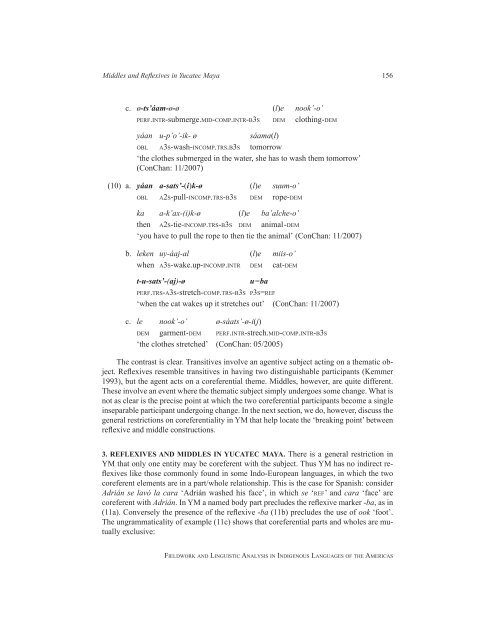Fieldwork and Linguistic Analysis in Indigenous ... - ScholarSpace
Fieldwork and Linguistic Analysis in Indigenous ... - ScholarSpace
Fieldwork and Linguistic Analysis in Indigenous ... - ScholarSpace
You also want an ePaper? Increase the reach of your titles
YUMPU automatically turns print PDFs into web optimized ePapers that Google loves.
Middles <strong>and</strong> Reflexives <strong>in</strong> Yucatec Maya 156<br />
c. ø-ts’áam-ø-ø (l)e nook’-o’<br />
Perf.<strong>in</strong>tr-submerge.mid-comP.<strong>in</strong>tr-b3s dem cloth<strong>in</strong>g-dem<br />
yáan u-p’o’-ik- ø sáama(l)<br />
obl a3s-wash-<strong>in</strong>comP.trs.b3s tomorrow<br />
‘the clothes submerged <strong>in</strong> the water, she has to wash them tomorrow’<br />
(ConChan: 11/2007)<br />
(10) a. yáan a-sats’-(i)k-ø (l)e suum-o’<br />
obl a2s-pull-<strong>in</strong>comP.trs-b3s dem rope-dem<br />
ka a-k’ax-(i)k-ø (l)e ba’alche-o’<br />
then a2s-tie-<strong>in</strong>comP.trs-b3s dem animal -dem<br />
‘you have to pull the rope to then tie the animal’ (ConChan: 11/2007)<br />
b. leken uy-áaj-al (l)e miis-o’<br />
when a3s-wake.up-<strong>in</strong>comP.<strong>in</strong>tr dem cat-dem<br />
t-u-sats’-(aj)-ø u=ba<br />
Perf.trs-a3s-stretch-comP.trs-b3s P3s=ref<br />
‘when the cat wakes up it stretches out’ (ConChan: 11/2007)<br />
c. le nook’-o’ ø-sáats’-ø-i(j)<br />
dem garment-dem Perf.<strong>in</strong>tr-strech.mid-comP.<strong>in</strong>tr-b3s<br />
‘the clothes stretched’ (ConChan: 05/2005)<br />
The contrast is clear. Transitives <strong>in</strong>volve an agentive subject act<strong>in</strong>g on a thematic object.<br />
Reflexives resemble transitives <strong>in</strong> hav<strong>in</strong>g two dist<strong>in</strong>guishable participants (Kemmer<br />
1993), but the agent acts on a coreferential theme. Middles, however, are quite different.<br />
These <strong>in</strong>volve an event where the thematic subject simply undergoes some change. What is<br />
not as clear is the precise po<strong>in</strong>t at which the two coreferential participants become a s<strong>in</strong>gle<br />
<strong>in</strong>separable participant undergo<strong>in</strong>g change. In the next section, we do, however, discuss the<br />
general restrictions on coreferentiality <strong>in</strong> YM that help locate the ‘break<strong>in</strong>g po<strong>in</strong>t’ between<br />
reflexive <strong>and</strong> middle constructions.<br />
3. REFLEXIVES AND MIDDLES IN YUCATEC MAYA. There is a general restriction <strong>in</strong><br />
YM that only one entity may be coreferent with the subject. Thus YM has no <strong>in</strong>direct reflexives<br />
like those commonly found <strong>in</strong> some Indo-European languages, <strong>in</strong> which the two<br />
coreferent elements are <strong>in</strong> a part/whole relationship. This is the case for Spanish: consider<br />
Adrián se lavó la cara ‘Adrián washed his face’, <strong>in</strong> which se ‘ref’ <strong>and</strong> cara ‘face’ are<br />
coreferent with Adrián. In YM a named body part precludes the reflexive marker -ba, as <strong>in</strong><br />
(11a). Conversely the presence of the reflexive -ba (11b) precludes the use of ook ‘foot’.<br />
The ungrammaticality of example (11c) shows that coreferential parts <strong>and</strong> wholes are mutually<br />
exclusive:<br />
fieldwork <strong>and</strong> l<strong>in</strong>guistic analysis <strong>in</strong> <strong>in</strong>digenous languages of the americas

















